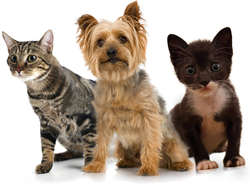Herbs Your Pet Will Love (And Some to Avoid): A Culinary Guide for Pet Parents
- ER Kent

- Aug 5
- 4 min read
You love sprinkling fresh herbs on your meals—but have you ever wondered if your pet might enjoy them too? Let’s explore the flavorful, fragrant world of herbs and how they can enhance your pet’s life safely.

Sniff, Nibble, Repeat: Why Pets Are Drawn to Herbs
From sniffing rosemary sprigs to batting at basil leaves, many dogs and cats are naturally curious about the plants you use in your kitchen. Herbs aren’t just aromatic—they’re packed with nutrients and essential oils that appeal to your pet’s senses.
But just because something is natural doesn’t mean it’s safe. That’s where this guide comes in.

Aromatic and Approved: Herbs That Are Safe for Dogs and Cats
Let’s dig into the pet-safe herbs you can use to add flair to your pet’s meals, improve digestion, and even freshen their breath.
✅ Parsley (Curly variety only)
Great for: Freshening breath, boosting vitamin K and C How to use it: Finely chop and mix a pinch into dog or cat food Caution: Avoid flat-leaf (Italian) parsley in large quantities—it’s high in furanocoumarins, which can be harmful in excess
✅ Basil
Great for: Anti-inflammatory effects, antioxidants How to use it: One or two shredded leaves as an occasional treat Bonus: Many cats enjoy batting basil around before nibbling
✅ Cilantro
Great for: Digestive health, detoxifying support How to use it: Add a pinch to cooked meals for dogs, or offer small amounts to cats who show interest
✅ Dill
Great for: Reducing gas, improving digestion How to use it: Mix into homemade pet treats or sprinkle over food Note: Dogs are more likely to appreciate dill than cats
✅ Thyme (fresh, not essential oil)
Great for: Antifungal properties, respiratory support How to use it: A few fresh leaves chopped into dog food—avoid dried thyme, which is more concentrated
✅ Rosemary (in moderation)
Great for: Natural antioxidant and preservative in homemade food How to use it: Add a tiny sprinkle of chopped fresh rosemary to dog food (not recommended for cats)
✅ Catnip (for cats only!)
Great for: Enrichment, exercise, stimulation How to use it: Offer dried or fresh leaves, or grow your own in a pot Fun fact: Not all cats respond to catnip—it’s genetic!

Proceed with Paws: Herbs That Should Be Avoided
Even well-meaning pet owners can make mistakes when it comes to herbs. Here are some common herbs that can be harmful or toxic to pets:
❌ Chives
Toxic to: Dogs and cats Symptoms: Vomiting, diarrhea, and in severe cases, red blood cell damage Why: Chives belong to the allium family, like onions and garlic, which are highly toxic to pets
❌ Garlic
Toxic to: Dogs and cats Symptoms: Lethargy, pale gums, gastrointestinal upset Why: Even small amounts can cause anemia over time
❌ Oregano (essential oil and dried)
Toxic to: Cats, and sometimes dogs in large doses Symptoms: Vomiting, diarrhea, drooling Why: High levels of phenols that can upset your pet’s system
❌ Tarragon
Toxic to: Dogs and cats Symptoms: Mild GI upset Why: Contains estragole, which is not safe for pets
❌ Lemongrass
Toxic to: Dogs and cats Why: Can cause vomiting and weakness when consumed in moderate amounts

A Garden of Enrichment: Growing Pet-Friendly Herbs at Home
Want to build a garden your pet can enjoy too? A windowsill or patio planter with the following combo makes a safe, aromatic, and functional setup:
Basil
Parsley
Dill
Catnip (for felines)
Thyme
Lemon balm (in very small doses, good for dog anxiety)
Pro tip: Keep your herb garden pesticide-free and organic—pets will be licking and nibbling these leaves, after all!

How to Safely Introduce Herbs to Your Pet’s Diet
Start with the basics:
Chop herbs finely so your pet doesn’t choke or gag on leaves
Mix into wet or dry food in tiny quantities—think “garnish,” not “salad”
Watch for reactions like diarrhea, vomiting, or unusual behavior. Stop immediately if any issues occur.
Consult your vet before adding herbs regularly, especially if your pet has existing health conditions

Fun DIY Ideas for Pet Parents with Herbs
Frozen herb treats: Blend parsley or basil with a little water and freeze in silicone molds
Homemade dog biscuits: Add finely chopped thyme and parsley to baked treats
Cat herb garden: Grow catnip, valerian, and lemongrass (for scent only) in a shallow planter
Basil sniff boxes: For scent enrichment, fill a box with basil sprigs and let your dog explore

Why This Matters: A Lifestyle Upgrade for Pets and People
Herbs are more than decorative garnishes—they’re flavorful, functional, and fun. For health-conscious pet parents who already cook at home or maintain a herb garden, this opens a new way to bond with your animal companion. Plus, it's a smart, natural alternative to store-bought treats with mystery ingredients.
As always, moderation is key. While a pinch of parsley can freshen your dog’s breath, a handful of oregano might send you on a vet visit. Keep it simple, smart, and supervised.

Final Takeaway:
🌿 Yes to basil, parsley, dill, and thyme
🚫 No to chives, garlic, tarragon, and oregano
🌱 Grow a pet-friendly herb garden for enrichment and nutrition
Disclaimer:
The content provided in this article is for informational and entertainment purposes only. I am not a veterinarian or licensed animal health professional. The information presented here is based on personal experience, research from reputable sources, and general pet care knowledge, but it should not be considered medical advice. Always consult with a qualified veterinarian or pet nutritionist before making any changes to your pet’s diet, health routine, or care regimen. Each pet is unique, and professional guidance is essential to ensure their safety and well-being.








Comments